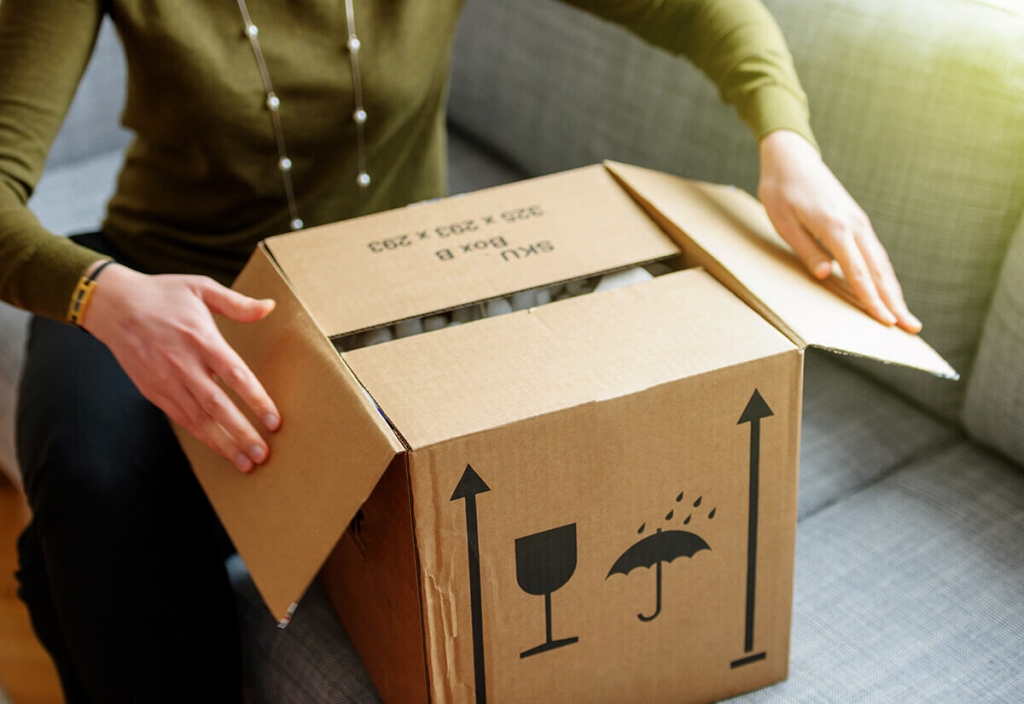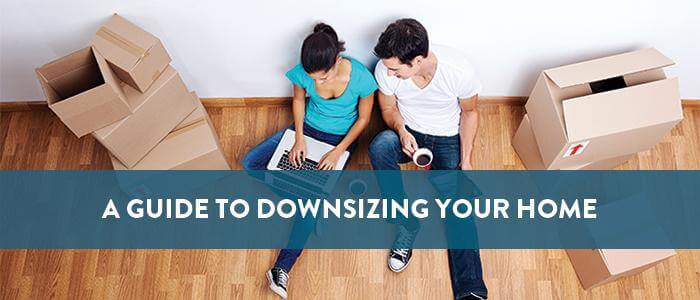Home downsizing isn’t just a trend amongst ‘empty nesters’, but is increasingly being observed by young families looking to reduce financial pressure, or those looking to move to more urban areas.
For some, downsizing is about moving to a smaller home that’s easier to manage. For others, it’s about decluttering and removing all the unnecessary items you’ve collected over the years.
Whether you’re changing from a house to an apartment or an apartment to a studio, there are some things to keep in mind when packing up your home and sorting through your belongings.

The benefits of downsizing
Downsizing can see you reap a whole host of benefits, most of them financial. Some of the benefits of downsizing are:
- You can reduce your mortgage: Depending on the location of your new home, downsizing can significantly reduce your mortgage repayments. Smaller homes generally cost less to run, and you will benefit from the savings on interest over the term of your mortgage.
- Increase retirement savings: Contribute the money you save on your mortgage to your retirement fund and watch your nest egg grow.
- More freedom: Downsizing to a smaller home means that you’ll have a more manageable home base from which you can travel more freely.
- Decrease bills: A smaller home means that you’ll pay less on utilities such as electricity, gas and heating.
- Less maintenance: If you move from a house to an apartment, you’ll see your housework decrease significantly.
- Clearer state of mind: Less mess, clutter, and debt will give you peace of mind and allow you to better enjoy your new home and lifestyle.
In this guide to downsizing, you’ll find practical advice on where to start, where to stop and how to successfully sort through the clutter and enjoy a fresh start in your new home.
1. Make a list of must-have items

When it comes to the most important act of downsizing – getting rid of stuff, it can be difficult to really know what you should keep and what you should throw away.
Certain items can be of sentimental value even if we never actually use them. Others that we can’t live without might be accidentally discarded because you happened to be in a bad mood that day (or just in a really good downsizing mood).
To counter this, start with writing down all the items you can’t live without before you begin decluttering. By creating a wish list, you will feel better about getting rid of things that didn’t make the cut, while ensuring your most prized possessions remain.
2. Create a floorplan
Most downsizing projects come about when we move house, particularly if that house is considerably smaller than the one you currently live in.
A floorplan is your best bet for ensuring your downsized domain is just right for you. Not only can you start planning where everything goes, but also how much will actually fit in the home. You might be able to obtain a floor of your real estate agent. If not, a pen and paper should do the trick. Here are the steps you should take to make sure everything fits perfectly in your new home:
- Make an inventory of everything you’re taking with you.
- Figure out where it’s all going. You might want to craft cutouts that can be moved around if you’re using pen and paper.
- Double check everything and make sure you’re being generous with your spacing. There’s no point trying to squeeze a double bed into a single room.
A floor plan won’t just help you downsize either, come moving day, you’ve already got the plan for the removalists ready to go!
3. Go through all those boxes

Hidden away in garages, closets, stacked in basements and beneath the stairs, every house has an untold number of boxes used to store things you probably no longer need.
In some cases, these boxes have followed you from place to place, often remaining unopened, just carted around in case we might someday need them, even if we’ve kind of forgotten what is actually in them.
These boxes contain everything from obsolete technical equipment to decade-old textbooks, fishing gear, old clothes you never wear, cables, birthday cards, toys and baby clothes; just about anything we accumulate as we go through life.
If you want to make a real dent in decluttering and downsizing, start with these boxes. You don’t have to throw them all out, but by simply going through and rediscovering what you actually need, you can probably reduce ten boxes down to two. Wouldn’t that be great?
4. Start your culling in the kitchen
The kitchen is the perfect place to start your downsizing adventure. Why? There’s really not much in the kitchen of sentimental value. Nobody is going to get teary-eyed over losing an extra mixing bowl, while the space you save can be used as extra storage in your downsized home.
It might be worth writing an inventory list of all kitchen supplies, so you have an idea of how much you have and what is in excess. List all utensils, silverware, Tupperware, bowls, plates, mugs and glasses; figure out how many you realistically use, and pack the rest up to donate to charity.
If you’re not ready to touch the kitchen, the garage is another place where clutter tends to build and just stay there. You’ll be amazed at just what can be repurposed and recycled from the garage area. Everything from old shoes and sporting gear to cans of paint, tools and old boxes.
If you’re new to de-cluttering, start in the areas where you’re less likely to hold a sentimental attachment to items and become stressed about what you should and shouldn’t keep.
5. Always aim to declutter

You don’t have to be a candidate for reality tv show level hoarding to benefit from the habit of decluttering. Clutter affects our lives in a myriad of different ways, just about all of them negative. By creating good habits you can streamline your household maintenance, reduce space dedicated to storage, and make things generally easier to find around the house.
Decluttering tip: Paper pileup
Bills, letters, marketing material, work documents and textbooks are just some of the paper clutter that builds up over time around the house. While we might dream of a paperless world without junk mail for now at least, it pays to have a decluttering process for all that paper. Follow these steps and keep your home paper-free:
- Recycle early: Sort your mail on the way from the letterbox, stuff you don’t want should go in the recycling before you set foot in the house. Just be sure to tear it up first to protect your privacy.
- Move your bills online: Pay your bills online and move your communications with utility providers and banks to email only.
- Schedule your life: For invitations to events, enter the information immediately into your calendar or scheduler. That way there’s no need to turn your fridge door into a filing cabinet for upcoming birthdays and weddings.
- Resell your textbooks: Thick and heavy space hogs, textbooks are prize candidates for decluttering. Unless you’re currently using them for study, you probably won’t need them in the future. Sell them off or donate them to your local library.
Decluttering tip: Heirloom hassles
As we move through life we inherit heirlooms from family and friends. These items form a connection that is meaningful, but they can also increase the amount of clutter around the home. This is particularly true if these heirlooms are only being stored, and don’t play a functional or decorative role around the home.
When decluttering your home, ask yourself these questions about any items you inherited:
- Do you use them for their intended purpose?
- Could they be repurposed to something useful?
- Is there someone you know that might be able to use them better?
- How much storage space are they taking up?
- What could you do with that space if you didn’t have the heirlooms?
Furniture, wall hangings and furnishings that are just crammed into storage are all items that create clutter. If they’ve been stored for a long time, it might be time for you to start moving them on.
6. Say goodbye after a year
How long should you hold onto something you don’t use before it is time to say goodbye?
Sometimes it’s tempting to look at seasonal items like winter jackets, pool toys, surfboards and skis and think ‘maybe next year’. And while there’s a case to be made that maybe next year you will indeed hit the slopes, in general, if you haven’t used something in twelve months, you’re probably never going to use it again.
Some other items to consider include:
- Workout gear and equipment.
- Old shoes.
- Clothes and toys that your kids have grown out of.
- Equipment from hobbies you’ve long since abandoned.
- Old video game consoles, computer equipment, VCRs and DVD players.
The one year rule can be extremely effective for most items. But you need to keep it realistic and perhaps hold onto those items that serve an occasional, specific purpose.
For example, your favourite suit or outfit for weddings and other formal events. There might come a 12 month period where you don’t go to any formal events. That doesn’t mean you need to get rid of it. If there’s a common sense reason to hold onto something for more than a year, then use your best judgement.
7. Recognise that not everything is just ‘stuff’

When it comes to ridding our homes of clutter and stored junk we can sometimes forget to sort the wheat from the chaff. Not all material possessions are created equal, and some hold value to us in ways that can’t be defined (or replaced).
If you’re not sure what’s really important to you, or worried about being too caught up in the quest to minimise everything, ask yourself this question. “If you have to leave right now, and never come back, what would you put in your bag?”
It might be some photo prints, a favourite book. A decorative item or souvenir from a trip. These items, while not something you’re actually ‘using’, are worth holding on to, regardless of how much you love to declutter.
8. Other reasons not to throw something away
It’s not just for personal reasons that you might want to hold on to some items, there are other concerns like safety and security to consider. There are a number of everyday household items that you might want to hold onto for safety, security and peace of mind:
- Emergency supplies: First aid kit, torch, landline phone and other items you will need in case of an emergency.
- Electronic storage devices: Don’t toss out anything that stores data until you’re sure all personal information has been removed. That includes smartphones, laptops, thumb drives, portable hard drives, computers, gaming systems and even smart TVs.
- Original boxes: Fine jewellery and other high-value items are worth more if they are kept in their original boxes.
9. Repurpose, Reuse, Recycle
The garbage should be the last place on your list when it comes to moving on unwanted items. Downsizing your home shouldn’t mean upsizing landfill. In fact, many of the things you choose to let go will have a use for someone else.
- Repurpose: Finding a new use for an old item is a fun and cost-effective way to invigorate your new home.
- Reuse: Before throwing away quality items, ask friends and family if they have a use for them.
- Recycle: Donate clothes, recycle all plastics, and ensure electronics are disposed of properly so the precious metals can be reused. For heavy items, organise a clean up will your local council, or contact professional removalists to help you move them off your property.
10. Go digital
The digital revolution is beneficial for space savers everywhere. Rather than keeping hard copies of everything, we can create digital versions that remain safe and secure on cloud storage devices. Not only are they backed up forever, but they can also be accessed from anywhere you have an internet connection, meaning you won’t have to carry them around or worry about storing your media between moves.
Here’s a list of just some of your personal stuff that can be digitised for easier access and storage:
- Home videos, cassettes and tapes.
- Personal photo collections.
- Important documents like birth certificates, contracts, insurance documents and wills.
Storing these possessions online doesn’t have to be expensive either. Services like Google Drive and Dropbox offer a lot of storage for free, and the monthly pricing schemes for more space aren’t too expensive either. The ease of access and the ability to share them with people all around the globe make going digital a great option for anyone looking to downsize their home.
11. Downsizing your bills and expenses

Now that you’ve successfully downsized and decluttered your home, it’s time to start looking at other ways you can sort through the clutter and streamline your life.
Declutter and downsize your bills
Start with your entertainment services. Foxtel, Stan and Netflix are prime candidates – do you really need all three? And what about your internet bill, do you actually use anywhere close to that 50GB plan you’re paying for? Perhaps you can shift down to 20GB only. The same goes for your phone plan, there are always competitive offers in that space, so it might be time to start looking at what else is on offer.
When it comes to utilities, there are a few ways you can save money there as well:
Replace your light bulbs
Your new, downsized life is all about efficiency, and LED light bulbs are far more efficient than halogens. Save on costs by replacing your old globes with long life, energy efficient ones and ‘declutter’ your energy bill.
Make your home ‘smart’
If you love how organised and easy going your new downsized home is, you’ll love being able to make it ‘smart’. The Internet of Things lets you connect up multiple devices around the home to give you more control over your environment. Everything from fridges and thermostats to the television, lights and sprinkler systems can be automated on your home network. This allows you to do cost-effective things like:
- Run the dishwasher during off-peak.
- Start heating the home slowly before people get home.
- Control blinds and shades for sunlight.
- The record shows to watch later (instead of buying them).
Downsizing to a smaller home?
Taking control of your life through streamlined efficiency is at the heart of downsizing. Remember what you’ve learned and try to apply it to your life whenever possible. You’ll find that simple is better, and smart is always more cost-effective. If you’re downsizing to a smaller home and need assistance with the move, Holloway is your guys to call to help move your precious belongings or store them in between.

